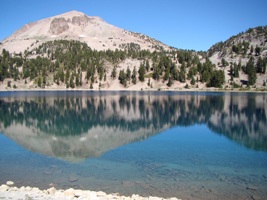Geology 185: Cascades Volcanoes Geology: Sept. 27-Oct. 1, 2018

The southern part of the Cascades Range contains some of the most striking examples of volcanism to be found anywhere in the world. We will see evidence of relatively calm eruptions of basalt lavas that flowed across the landscape forming pahoehoe and aa flows and lava tubes that extend for miles underground. We will see the remains of unimaginable large explosions that caused whole mountains to disappear. You will have the opportunity to understand the causes of these eruptions and their potential for future activity.
This trip will be a rigorous test of your patience and health. There will be several long driving days, and conditions may become harsh. Rain, snow, and extreme cold are serious possibilities. The success of the trip will depend on your amiability and willingness to put up with inclement conditions.
Syllabus & Documents
What to Expect
Date: September 27 - October 1, 2018
Leave Thursday, Sept. 27 at 4:00 pm (north side Science Community Center) –Arrange for off-campus parking
Return Monday, October 1 at about 8:00 pm
*Note: you will be missing two days of school. Make arrangements now to make up any missed work.
Cost: $80.00, payable in the MJC Business Office. This fee must be paid prior to the trip in the MJC Business Office (currently on east campus).
Academics: 2 units. Add code available from Garry Hayes, SCC 336 (hayesg (at) Yosemite.edu). Space is limited.
Recommended Text: Fire Mountains of the West by Stephen Harris
Academic Requirements: See PDF link above
Objectives (Student Learning Outcomes):
By the end of the course, the student will be able to
- Compare and contrast landscapes formed by mass-wasting, river erosion, glaciation, and volcanism.
- Recognize the features produced by glacial activity
- Discuss the role of convergent and divergent tectonic boundaries in the formation of a magmatic arc, and in the construction of mountain ranges such as the Cascades.
- Distinguish between the major types of igneous plutonic and volcanic rocks.
- Explain the process by which calderas are formed, and how Medicine Lake caldera developed.
- Compare and contrast shields, composite cones, cinder cones, plug domes and basalt plateaus, as seen in or near Crater Lake and Lassen Volcanic National Parks, Lava Beds National Monument, and Mt. Shasta.
- Describe the consequences of interactions between humans and the natural environment at each of the parks we will visit, including the causes and resolution of the Modoc Indian War of 1872-73

